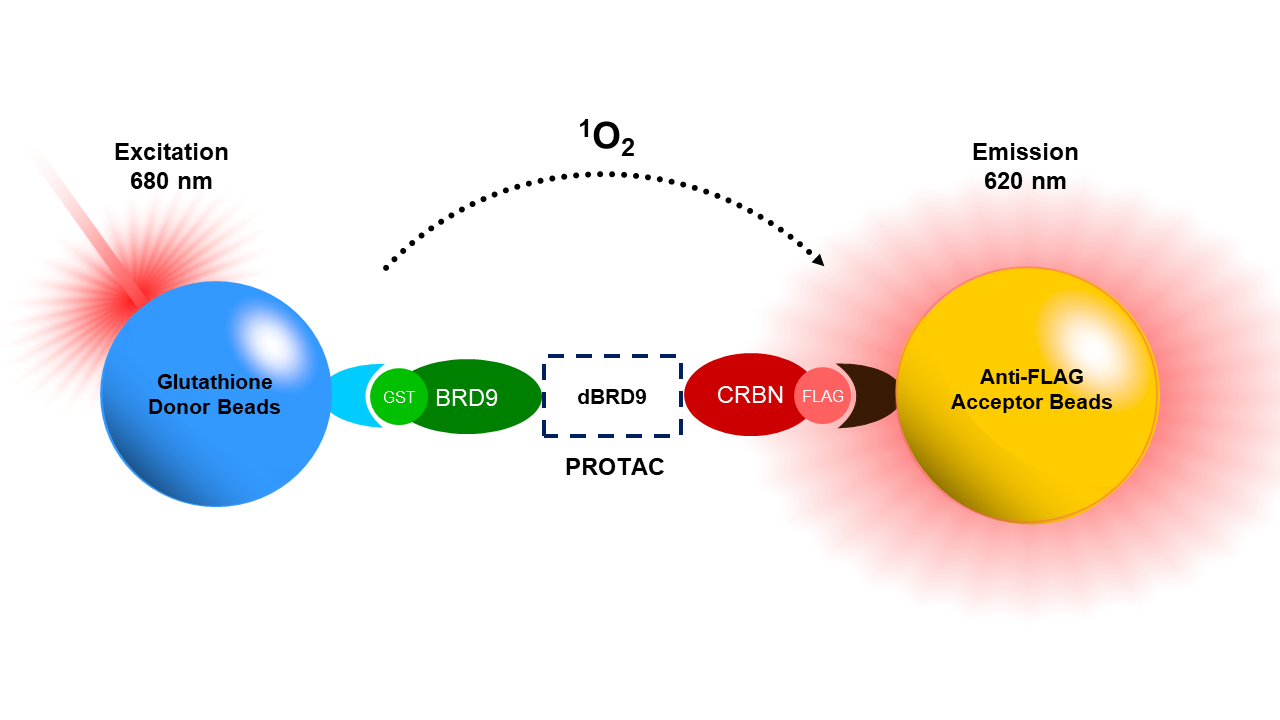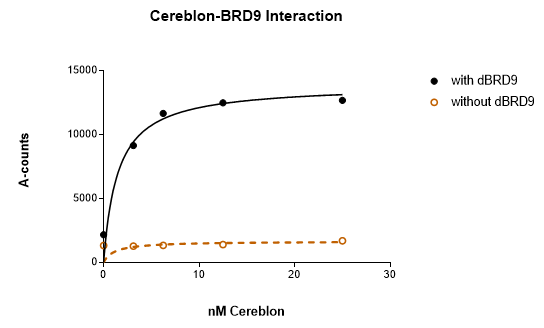PROTAC® Optimization Kit for BRD9-Cereblon Binding
The PROTAC® Optimization Kit for BRD9-Cereblon Binding is designed for the testing and profiling of PROTACs® directed against BRD9 and Cereblon (CRBN). The BRD9 inhibitor BI-7273 is included as a control inhibitor of PROTAC® binding to BRD9. With this kit, three simple steps are required for the measurement of PROTAC® activity. First, the PROTAC® of interest is incubated with CRBN and BRD9. Next, acceptor beads are added, then donor beads, followed by reading of the Alpha-counts.

Illustration of the assay principle: a PROTAC® of interest or positive control dBRD9 (PROTAC®) interacts with both BRD9 and CRBN, bringing them in close proximity. BRD9 contains a GST tag, recognized by the GSH donor bead, while CRBN contains a FLAG tag that binds to the AlphaLISA™ acceptor bead conjugated with an anti-FLAG antibody. Upon excitation of the donor bead a singlet oxygen is generated by the donor bead, which excites the acceptor bead and emits light proportionally to the level of interaction. AlphaLISA™ immunoassays are a no-wash alternative to ELISA immunoassays. These assays are robust and ideal for a minimal hands-on approach.
Need us to run inhibitor screens or profile your compounds against PROTAC® Optimization for BRD9-Cereblon Binding? Check out our Bromodomain Screening Services or PROTACs ® & Protein Degradation Services.
- AlphaLISA™ anti-FLAG acceptor beads, 5 mg/ml (PerkinElmer #AL112C)
- Alpha™ GSH donor beads, 5 mg/ml (PerkinElmer #6765300)
- Optiplate 384 (PerkinElmer #6007290)
- AlphaScreen™ microplate reader
- Adjustable micropipettor and sterile tips
| Catalog # | Name | Amount | Storage |
| 100255 | FLAG-Cereblon* | 5 µg | -80°C |
| 31091 | GST-BRD9* | 40 µg | -80°C |
| 1 mM dBRD9 PROTAC® (MW=884 Da) | 15 µl | -80°C | |
| 3x BRD9 PROTAC® Buffer** | 4 ml | -20°C | |
| 10 mM BI-7273 (MW=353 Da) | 15 µl | -20°C |
*The concentration of the proteins is lot-specific and will be indicated on the tube.
**Add 30 µl of 0.5 mM DTT to the assay buffer before experiment.
CRBN (cereblon) is the substrate-binding component of the E3 protein ligase complex DDB1-CUL4A-RBX1 involved in the ubiquitination and proteasomal degradation of target proteins. Cereblon binds to DDB1 (Damaged DNA binding protein 1), to the scaffolding protein CUL4A (Cullin 4A), and its regulator RBX1 (RING-Box protein 1). Binding of CRBN to a substrate protein engages the E3 ligase activity of the complex and results in the ubiquitination and ultimate degradation of the protein substrate. Many proteins are known targets of CRBN, including several transcription factors, growth factors, kinases and more. CRBN has become a target of choice for the development of many therapeutic PROTACs®.
BRD9 (Bromodomain-containing protein 9) functions as a transcriptional regulator and is a component of a chromatin remodeling complex. It also regulates the formation of the RAD51-RAD54 complex, involved in homologous recombination. BRD9 plays a role in cancer and is a potential therapeutic target for cancer drugs.



